9 Trends in Assisted Living and Memory Care Facilities
Estimated Read Time: 5 Minutes
The Highlights
Discover how calming color palettes reduce anxiety and support cognitive health
Learn which tech upgrades truly support independence without overwhelming staff
Explore design choices that ease transitions for memory care residents
See flexible, residential-style interiors that don’t sacrifice safety or compliance
Understand why thoughtful accessibility isn’t just ADA-compliant — it’s empowering
In senior living and memory care communities, design directly shapes how residents experience their day — from finding their room with ease to feeling relaxed in shared spaces.
Soft color palettes, cozy furnishings, and smart technology aren’t just aesthetic choices; they’re tools that support mental health, promote independence, and simplify daily routines for both residents and staff.
Whether you’re planning a new build or refreshing an existing facility, these thoughtful design trends are transforming healthcare spaces into environments where residents can feel comfortable, confident, and truly at home.
1. Soothing and Neutral Color Palettes for Assisted Living Facilities
Soothing and neutral color palettes in assisted living and memory care facilities play a vital role in fostering a calm, peaceful environment that supports the mental and emotional well-being of residents.
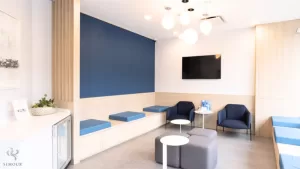
Soft, muted colors such as pale blues, light greens, and warm neutrals — are known to reduce anxiety and promote relaxation, making them especially beneficial for individuals with cognitive impairments like dementia or Alzheimer’s.
These soothing tones help minimize overstimulation and contribute to a more comforting environment that can reduce confusion and support emotional well-being. Incorporating these colors throughout the facility — on walls, trim, and furnishings — helps create a warm, home-like environment that offers residents a greater sense of comfort and security. It’s easy to see why these palettes are a part of larger living trends.
2. Purpose-Driven Design
Thoughtful, purpose-driven design in healthcare facilities -particularly in assisted living and memory care environments- has evolved to prioritize not only the aesthetic appeal but also the safety, accessibility, and overall well-being of residents.
Designers are increasingly focused on creating spaces that are both functional and comforting, integrating features that support the daily lives of seniors while enhancing their quality of life.
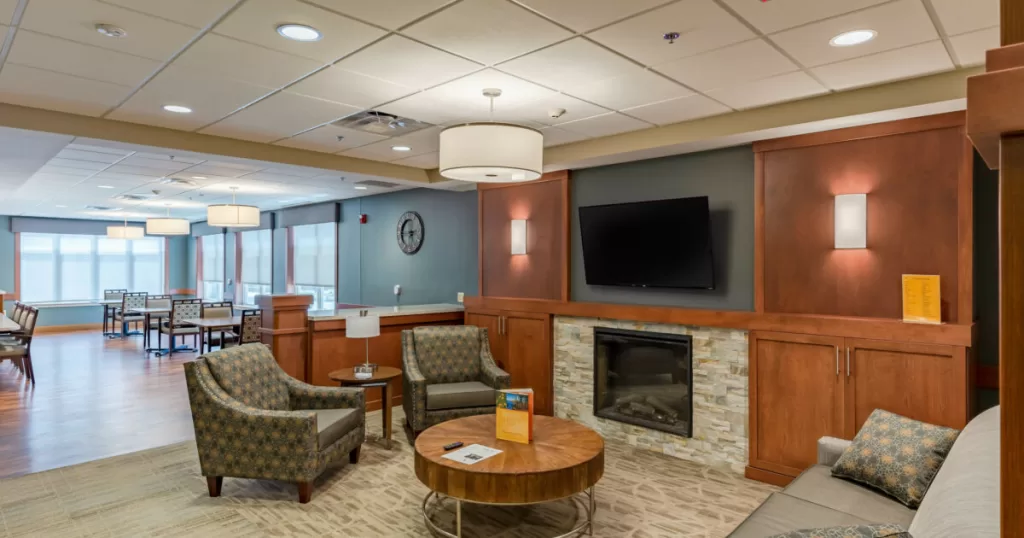
Soft, ambient lighting is a key element, as it reduces harsh glares and creates a calming atmosphere, which is essential for individuals with sensory sensitivities. Fixtures and furnishings should be carefully selected for ease of use. Ensure that residents can operate them with minimal effort, whether it’s light switches, faucets, or handles. Lastly, clear and unobstructed pathways are a key part of the design, helping reduce fall risks and making the facility easier to navigate — especially for residents with mobility challenges.
But safety is only one part of the equation. Essential healthcare tools and equipment should be thoughtfully integrated into the environment, allowing staff to deliver quality care without making the space feel clinical or sterile .
This balance of safety, accessibility, and comfort creates an environment where residents feel secure, supported, and independent — all within a space designed around their unique needs.
3. Residential-Inspired Senior Living Interior Design
Modern senior living facilities are increasingly embracing a residential-inspired approach to interior design, focusing on creating spaces that feel like home. The goal is to foster a sense of comfort and belonging for residents, blending functionality with warmth and style.
Curated color schemes are carefully chosen to create a welcoming and harmonious atmosphere, often incorporating soft, neutral tones that promote relaxation while reflecting contemporary trends in interior design.
Inviting lounge areas are thoughtfully integrated, offering comfortable seating arrangements where residents can socialize, relax, or engage in recreational activities.
These spaces often feature plush, soft furnishings such as cozy sofas, armchairs, and pillows that encourage relaxation and create a homelike ambiance. Additionally, elements like natural light, decorative plants, and artwork are incorporated to enhance the overall aesthetic, making the space feel lively yet peaceful.
This not only contributes to a more pleasing visual environment but also improves residents’ mental and emotional well-being by providing familiar, comfortable spaces where they can enjoy a sense of normalcy and independence.
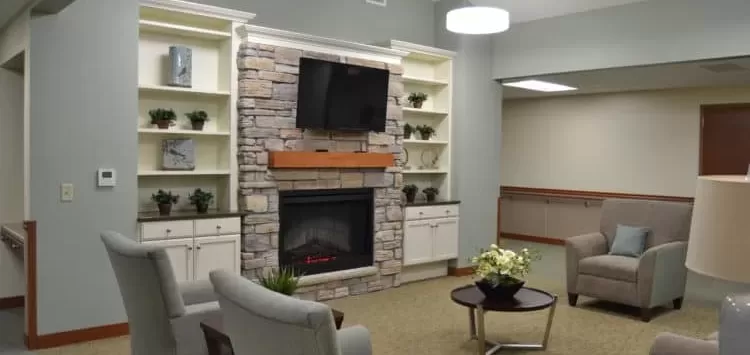
4. At-Home Assisted Living Feel
Many facilities are incorporating at-home assisted living features such as personalized memory boxes, private family rooms, and adaptable spaces tailored to individual needs.
These thoughtful design elements play a key role in enhancing resident well-being. Personalized memory boxes, for example, offer visual cues that help with wayfinding and familiarity, especially for residents with memory loss. Private family rooms create a
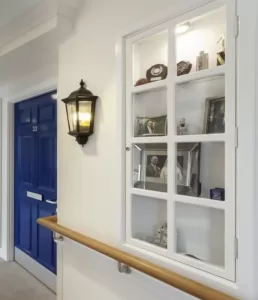
welcoming space for connection and meaningful visits, helping residents maintain strong relationships with loved ones. Adaptable spaces ensure environments can evolve with changing care needs, supporting long-term comfort and reducing the stress of relocation.
Altogether, this approach creates a more human-centered experience that promotes emotional security during what can be a difficult transition.
5. Dementia-Friendly Design Innovations
Special focus is being given to assisted living for dementia patients, with design strategies that prioritize safety, clarity, and independence. Elements like color-coded flooring and strong contrast between walls and handrails help residents navigate their environment with greater ease, reducing confusion and fall risk.
Drawing inspiration from hospital wayfinding systems, these design features use consistent visual cues, signage, and layout to guide residents intuitively through the space. By addressing both cognitive and physical needs, every feature is intentionally crafted to empower seniors with safety, confidence, and comfort, supporting a higher quality of life in a familiar, easy-to-navigate environment.
6. Smart Technology Integration
The rise of senior living technology is transforming how facilities are designed, with a growing emphasis on safety, convenience, and personalized care.
Driven by ongoing technological advancements in smart devices, today’s senior living spaces are being designed to support independent living and make it easier to track health needs.
Devices such as a fall detection watch or a smart watch for seniors not only alert caregivers and staff in the event of a fall but also track movement, heart rate, and activity levels — offering real-time insights into a resident’s well-being.
In addition, features like motion-activated lighting reduce fall risk by illuminating pathways without the need for switches, especially during nighttime hours.
These innovations are no longer considered luxury add-ons — they’re standard expectations in modern facility planning. By embracing smart technology, senior living communities can offer more independence to residents while giving families and care teams greater peace of mind.
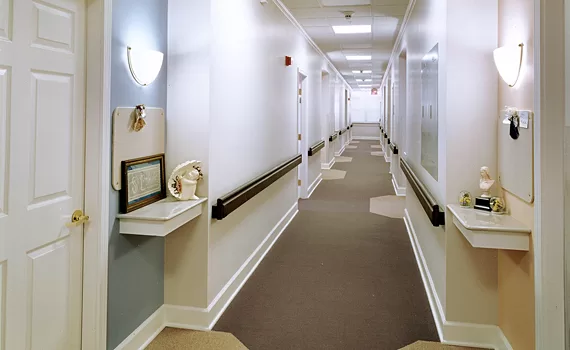
7. Outdoor and Garden Spaces
Incorporating garden and outdoor decor and intentionally designing areas for gardening as a therapeutic activity has become an essential part of modern senior living environments.
These outdoor spaces do more than just enhance curb appeal — they play a critical role in promoting senior health and wellness. Gardening has been shown to reduce stress, improve mood, and even support cognitive function, making it an ideal therapeutic activity for older adults.
Raised garden beds, accessible pathways, and shaded seating areas allow residents of all mobility levels to engage with nature safely and comfortably.
Beyond its physical benefits, gardening also fosters a sense of purpose, routine, and community. Whether it’s tending to flowers, herbs, or vegetables, these activities encourage gentle physical movement and provide meaningful opportunities for socialization.
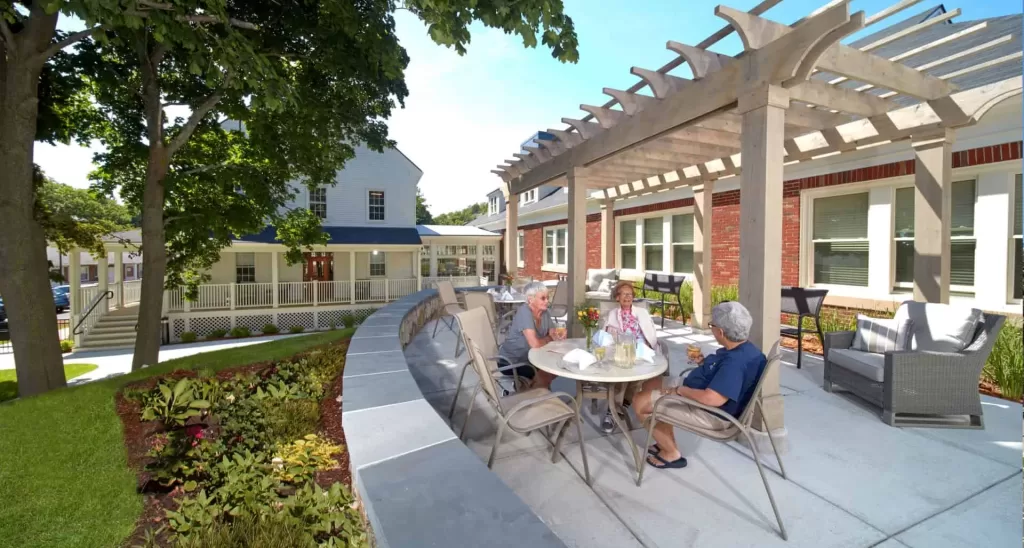
8. Flexible, Multi-Use Spaces in Senior Living
Modern senior living facilities are increasingly being designed with adaptable areas that serve multiple functions — from group fitness classes to therapy sessions to social gatherings. These flexible spaces support a wide range of programming that enhances fitness and wellness, fosters mental stimulation, and encourages meaningful connection.
These same spaces can also be used for cognitive remediation therapy, which focuses on strengthening memory, attention, and problem-solving skills through targeted exercises and activities that support brain health.
Additionally, these multipurpose areas create opportunities for intergenerational programs for seniors, where residents can engage with younger generations through shared activities like art workshops, storytelling, and community events. These connections not only reduce feelings of isolation but also bring joy, purpose, and a renewed sense of belonging.
By designing with flexibility in mind, facilities can evolve to meet the changing needs of residents while fostering a holistic sense of wellness.
9. Sensory and Cozy Room Design
Sensory room decorations and cozy spaces play a vital role in senior care settings, where the environment can have a profound impact on residents. These spaces are created to be both comforting and engaging, supporting relaxation while also offering gentle mental stimulation.
Soft furnishings like comfortable seating, warm blankets, and layered lighting help create a sense of safety and familiarity, which is essential for individuals living with dementia or cognitive decline.
Meanwhile, textured surfaces — from tactile wall panels to varied fabric textures — offer residents a way to stay engaged with their environment, supporting sensory input that can help trigger memory or spark curiosity.
By carefully curating sensory experiences, these rooms help reduce agitation, promote emotional regulation, and provide moments of peace and connection. In memory care, these elements are a fundamental part of person-centered care.
Final Thoughts
Senior living trends are evolving quickly, with a growing emphasis on comfort, safety, and connection. By embracing innovative, adaptable design, healthcare facilities can offer elevated living experiences. Collaborating with top interior designers and commercial design experts ensures these spaces remain flexible and ready to meet the changing needs of seniors.
Discover how IOC Construction is building spaces where seniors can truly thrive.
